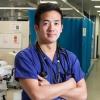
|
Authors | Institution |
| Matthew Mak | University College London Royal College of Physicians, London |
 |
|
||||||
| Thinking outside the classroom: social media and undergraduate medical education |
Medical education is dynamic and the opportunity to lead in new approaches is essential if we want it to develop.
Social Media promotes tacit knowledge transfer but there remains a role for traditional teaching methods.
Medical Schools and educators should embrace social media as a useful adjunct to deliver 21st Century medical Education
Medicine is a career of lifelong learning. Even before students embark on their studies at medical school, their academic rigour is tested at GCSE and at A-Level. Learning at medical school is traditionally through a mixture of methods including lectures, problem based learning and role modelling on the wards and in clinics.
Web 2.0 is a term used to describe the range of interactive and user-generated aspects of the Internet. Digital content and information in the era of the World Wide Web is no longer made by the media, but is co-created by private individuals connected via online networks, who collaborate and disseminate information across the globe. In contrast to old websites on the Internet where users were mainly consumers of content, Web 2.0 actively encourages participation.
Social Media is a term used to describe platforms which allow users to network and form collaborative spaces. Most platforms have features which include user profiles, blogs, messaging boards, photo or video sharing. The estimated number of people worldwide using social media was 798 million in 2011. This number is expected to rise to over 1.2 billion by 2015.
New technology is changing education systems around the world. This has lead to a revolution in both teaching and learning globally. Often driven by the digital expertise of young students, this new learning is interactive, collaborative and easily accessible. It exists more often out of scheduled teaching time, in non-formal settings and through peer networks.
Social media is also being widely used within the field of education, with platforms like Facebook and Twitter revolutionising classrooms by encouraging interaction and critical thinking.
This study seeks to explore the phenomenon of social media within medical education and to explain how social media impacts on medical students' education. This study will also provide a deeper understanding of how and why students learn through social media and help identify its role in the future of medical education.
This work was undertaken as part of a Masters research study in Medical Education. A structured online questionnaire was posted using Google Forms for 30 days between February and March 2013. Invitations to complete the survey were sent via e-mail, and posted onto social networking sites including Facebook and Twitter. The invitation specifically targeted healthcare professionals including doctors and medical students. Respondents were asked to answer sixteen questions on their use of social media platforms and attitudes towards social media. Respondents were also invited to indicate by way of leaving a contact e-mail address if they would like to be considered for follow-up interviews based on the results of the questionnaire. Quantitative data analysis was performed using Microsoft Excel 2007. Basic demographic data were analysed alongside responses to the other questions, including free-text responses. This poster is a report from the medical student reponses.
1090 responses to the online survey were received between the 3rd of February and the 3rd of March 2013. 290 of these were from medical students. 70% of medical students felt that social media contributed to their learning at least weekly and 75% of students agreed that they found social media helpful in developing their clinical education. However, 65% of medical students did not agree with the statement that they learnt more from social media than lectures and 76% disagreed with the fact that social media had replaced the traditional methods of learning in medicine.

More and more studies are entering the medical literature as social media becomes integrated into medical school and postgraduate medical curricula. However, there remains a significant body of doubt amongst the profession about how best to utilise these tools.
Attitudes towards social media were on the whole positive, with a large number of respondents agreeing that social media was helpful in developing their clinical education. However, there was agreement that social media had not replaced traditional methods of learning in medicine. Although a small percentage of respondents thought it was a waste of time, the majority thought that they spent too much time using social media. This highlights the need for any education which is delivered via social media to be concise and easily accessible.
Not only is social media a cultural phenomenon but a pedagogical one. Social media has made a significant impact on the educational experiences of healthcare professionals. Its immediacy and ease of access connects users to a global community of like minded individuals. Learners benefit from not only the speed of access to other like-minded professionals, but also from the experience of the collective and sharing of stories. Clinical discussions can be facilitated through social media, and best practice shared along with links to evidence based journal articles, videos or clinical images.
 Send Email
Send Email